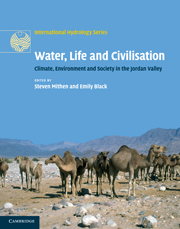Book contents
- Frontmatter
- Contents
- List of figures
- List of tables
- List of contributors
- Acknowledgements
- 1 Introduction: an interdisciplinary approach to Water, Life and Civilisation
- Part I Past, present and future climate
- Part II The palaeoenvironmental record
- Part III Hydrological studies of the Jordan Valley
- Part IV Human settlement, climate change, hydrology and water management
- 14 The archaeology of water management in the Jordan Valley from the Epipalaeolithic to the Nabataean, 21,000 BP (19,000 BC) to AD 106
- 15 From global climate change to local impact in Wadi Faynan, southern Jordan: ten millennia of human settlement in its hydrological context
- 16 Palaeoenvironmental reconstruction at Beidha, southern Jordan (c. 18,000–8,500 BP): Implications for human occupation during the Natufian and Pre-Pottery Neolithic
- 17 The influence of water on Chalcolithic and Early Bronze Age settlement patterns in the southern Levant
- 18 Modelling water resources and climate change at the Bronze Age site of Jawa in northern Jordan: a new approach utilising stochastic simulation techniques
- 19 A millennium of rainfall, settlement and water management at Humayma, southern Jordan, c. 2,050–1,150 BP (100 BC to AD 800)
- Part V Palaeoeconomies and developing archaeological methodologies
- Part VI Society, economy and water today
- Part VII Conclusions
- Index
- Plate section
- References
14 - The archaeology of water management in the Jordan Valley from the Epipalaeolithic to the Nabataean, 21,000 BP (19,000 BC) to AD 106
from Part IV - Human settlement, climate change, hydrology and water management
Published online by Cambridge University Press: 26 April 2011
- Frontmatter
- Contents
- List of figures
- List of tables
- List of contributors
- Acknowledgements
- 1 Introduction: an interdisciplinary approach to Water, Life and Civilisation
- Part I Past, present and future climate
- Part II The palaeoenvironmental record
- Part III Hydrological studies of the Jordan Valley
- Part IV Human settlement, climate change, hydrology and water management
- 14 The archaeology of water management in the Jordan Valley from the Epipalaeolithic to the Nabataean, 21,000 BP (19,000 BC) to AD 106
- 15 From global climate change to local impact in Wadi Faynan, southern Jordan: ten millennia of human settlement in its hydrological context
- 16 Palaeoenvironmental reconstruction at Beidha, southern Jordan (c. 18,000–8,500 BP): Implications for human occupation during the Natufian and Pre-Pottery Neolithic
- 17 The influence of water on Chalcolithic and Early Bronze Age settlement patterns in the southern Levant
- 18 Modelling water resources and climate change at the Bronze Age site of Jawa in northern Jordan: a new approach utilising stochastic simulation techniques
- 19 A millennium of rainfall, settlement and water management at Humayma, southern Jordan, c. 2,050–1,150 BP (100 BC to AD 800)
- Part V Palaeoeconomies and developing archaeological methodologies
- Part VI Society, economy and water today
- Part VII Conclusions
- Index
- Plate section
- References
Summary
ABSTRACT
This chapter reviews the archaeological evidence for water management in the Jordan Valley between the Last Glacial Maximum at 21,000 years ago and the annexation of the Nabataean Kingdom into the Roman Empire at AD 106 – the chronological bounds of the Water, Life and Civilisation project. It summarises the human need for water and available sources in the region before addressing the archaeological evidence for water management in the Epipalaeolithic, Neolithic, Bronze Age, Iron Age and Nabataean, with some consideration of the environmental, demographic social and economic influences that were either a cause or a consequence of changes in water management strategies. Greatest emphasis within the chapter is placed on the Neolithic period in light of relatively new archaeological discoveries that have not previously been drawn together in a review, and on the key role that water management may have played in the transition from hunting and gathering lifestyles. In contrast, the evidence for Nabataean water management has already received extensive consideration from other authors and is succinctly summarised towards the end of this chapter with a set of references leading to further information. As a whole, this chapter seeks to provide the archaeological background for the case studies that follow in Chapters 15–19 of this volume.
- Type
- Chapter
- Information
- Water, Life and CivilisationClimate, Environment and Society in the Jordan Valley, pp. 191 - 217Publisher: Cambridge University PressPrint publication year: 2011
References
- 5
- Cited by

